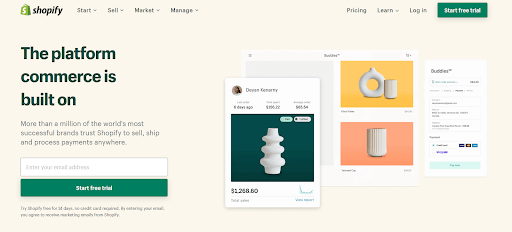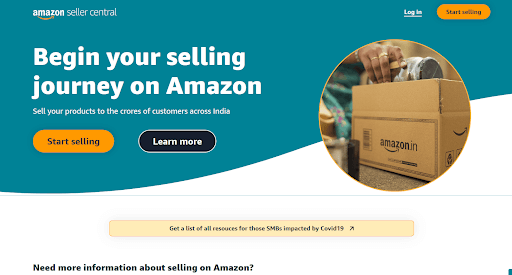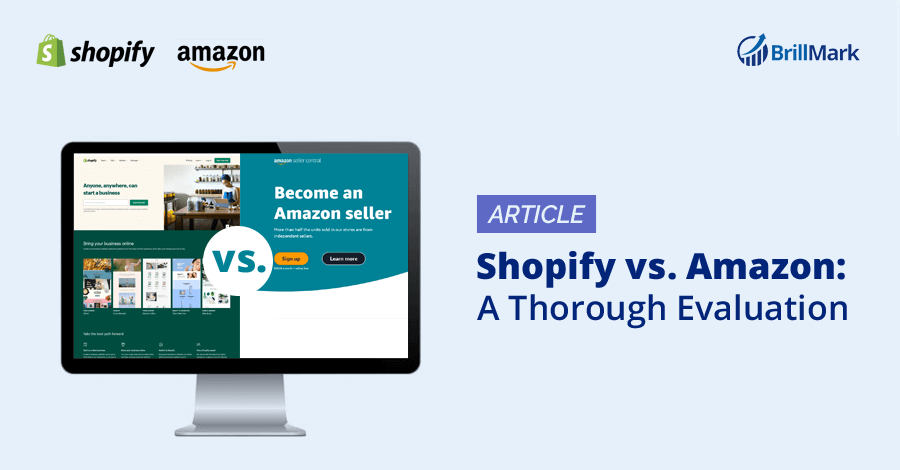One of the most important decisions you can make as a digital company owner is which e-commerce platforms to use for selling your items online — and, as two of the largest names in e-commerce, it’s likely you’ll wind up picking either Shopify or Amazon. While each has its pros and cons, you may discover that using both platforms is actually best for your organization.
If you plan to sell on Amazon, you can take advantage of the platform’s massive, established Amazon customer base without having to do the promotion yourself. However, with Shopify, you have complete control over your online store’s logo, layout, and consumer experience.
We’ve conducted extensive research on e-commerce platforms in order to provide you with the most accurate information. This article will analyze Shopify with Amazon in terms of usability, cost, functionality, customer service, and other factors. To figure out which one is ideal for your company, use this guide to help you make a decision.
| Platform | Shopify | Amazon |
| Launch Date | 2006 | 1994 |
| Overview | Shopify is a specialized e-commerce platform that provides all the technology to build your own online store, from the design of your shop to delivery. | Amazon is an online marketplace that allows you to sell alongside other online vendors while requiring nothing in the way of website building expertise. |
| Users | 4,000,000+ | 16,000,000+ |
| Ease Of Use | Easy | Easy |
| Customizability | Flexible | Not very flexible |
| E-commerce Toolkit | Yes | Yes |
| Pricing | Starting at $29 | For Individuals: $0.99 per unit sold For Business: $39.99 per month |
| Support | 24-7 | Not very accessible |
| Conclusion | Shopify is an ideal platform for small businesses looking to expand their online business. | Amazon is ideal for small sellers who do not want to pay an upfront charge and who want instant access to an already established audience. |
Overview
Shopify

Shopify is a sophisticated e-commerce platform that offers all of the technology needed to create your own online store, from design to delivery. Because of Shopify’s simple, user-friendly system, you don’t need technical abilities to create a website or e-commerce platform for your business.
Furthermore, Shopify offers hundreds of connectors that improve the operation of your business and allow different apps to communicate with one another. This is helpful if you already use a lot of apps to run your online business.
Shopify is suitable for both large and small businesses. Thousands of goods are available to millions of clients through this platform, which is used by merchants from all over the world.
Amazon

Amazon is With Amazon, you create a marketplace page for yourself to sell your items alongside those of other businesses while requiring nothing in the way of website building expertise. It is a well-established market. It is also pretty simple to use; however, picture uploads can take some time.
As a marketplace, Amazon allows third-party vendors to advertise their items on the internet. The sellers own the inventory. However, Amazon offers its own items as well, essentially competing with other vendors.
Users
Shopify
Shopify’s user base has grown dramatically in recent years. There are currently 4,000,000+ users using it.
Amazon
The Amazon user base has been increasing at a tremendous speed for some time now. It’s currently used by 16,000,000+ users.
Ease of Use
Shopify
Getting started with Shopify is like being given the keys to a fully functioning storefront. You have a functioning online marketplace from the start of your membership. Predesigned templates are adaptable for use on many devices and provide many customization possibilities. Because the panels and menus are simple, you can master using Shopify as you go.
Shopify also provides access to a Shopify Experts Marketplace, where you can engage a professional to help with setup, SEO, and other tasks.
Amazon
With Amazon, all you have to do is establish a profile, go through each set-up stage, and you’re ready to start selling! Once established, all you have to do is advertise your items, sell them, deliver them, and — the best part — be compensated!
All of this is quite easy, and Amazon provides tools to make it as smooth as possible. For example, you can handle delivery yourself or utilize Fulfillment by Amazon (FBA).
FBA takes one of the e-commerce world’s biggest difficulties — shipping — off your plate. So if you don’t want to worry about delivery, you don’t have to. Instead, you can simply sell your items, and Amazon handles the rest.
Customizability
Shopify
In regard to customization options and design, Shopify is at the extreme end of the spectrum — the options are almost endless. You’ll have access to the administration of your website, where you can choose from over 60 themes.
After you’ve decided on a theme, you can personalize, tweak, and rearrange it to your heart’s content. With their free and premium themes, Shopify allows you to express your brand’s style in whatever way you choose. They also offer a plethora of accessible extensions that you can add to your website to improve the client experience.
Amazon
Amazon’s designs are more constrained. The layout of all Amazon pages remains consistent. Although you can submit your own photos and information, the general style and appearance of your store page are clearly Amazon’s instead of yours.
Amazon does let you change some aspects, but it is far less versatile than Shopify.
E-commerce Toolkit
Shopify
Shopify is well-known for the breadth and power of its online sales features. This makes it an ideal choice for businesses looking to grow and use a number of strategies to sell and market their brand.
Shopify also has a fantastic app store, where you can add whatever extra functionality you need to their already broad toolset. (Please bear in mind that some plugins might be pricier than others.)
Amazon
Amazon’s marketplace sells a wide range of items, from electronics to toys to books. You can even offer services as opposed to actual products. It accepts both individual and company sellers and provides the resources necessary to assist your online selling.
One example is the Fulfillment by Amazon (FBA) program, which gives you access to Amazon Prime consumers while also allowing Amazon to handle the storage, packaging, and delivery of your items. You deliver your items to Amazon, which then packages and ships them to consumers as products sell. There are expenses for this, but if you don’t want to bother with shipping, it’s a good option.
Pricing
Shopify
Shopify has three plans:
- Basic Shopify is $29 a month. This is best for startups or those who are switching from online to in-person sales.
- The standard Shopify plan is $79 per month. It’s best for growing businesses with a single retail store.
- Advanced Shopify is $299 per month including all the features of other plans. It’s ideal for growing companies with two or more retail locations.
Shopify also offers a 14-day free trial to introduce businesses to the Shopify platform before utilizing it fully, and you don’t have to provide any financial information to use it.
Amazon
The Professional Selling package is $39.99 per month, plus any additional selling expenses (which vary depending on your products).
There is no monthly charge with the Individual Selling plan; instead, you pay $0.99 per item sold. This is in addition to any other selling costs, which vary by category.
The Individual plan is appropriate for anyone who expects to sell fewer than 40 products each month. As a result, it has fewer features available. On the Individual plan, for example, you cannot modify delivery prices.
Support
Shopify
Customers can contact Shopify’s support team by phone, email, chat, or social media. It is available 24 hours a day, seven days a week.
Amazon
Amazon does not have the most user-friendly support network. There is phone support, where you request a call, and Amazon contacts you. There are also forms you can fill out to get assistance, as well as community forums where you can share your concerns. However, this isn’t the simplest or user-friendly support structure.
Conclusion
After reading this article, we hope you have a clear idea of where these two platforms differ and where each platform shines. Several factors must be considered when deciding which e-commerce platform to use, including your technical ability, budget, shop size, and required functionality, to name a few.
- Shopify is the best platform for small businesses looking to expand their online presence.
- Amazon is ideal for small sellers who do not want to pay an upfront charge and who want instant access to an already established audience.
Now, if you want the best of both worlds, don’t worry — with the Shopify App Store, you can easily integrate Amazon with your Shopify store. This allows you to generate Amazon listings and offers directly from Shopify as well as sync inventory and product data, link items, and much more. You can start your own e-commerce store while marketing your items on the world’s biggest marketplace at the same time, and with only a few clicks.
The key thing to remember is that you must subscribe to an Amazon Professional Seller account to make this integration work. You’ll already be paying for your Shopify monthly membership, and you’ll be adding the Amazon Professional plan on top of that.
However, merging these two giants is a worthy investment if your company is ready for additional exposure and development. It’s a win-win situation!
We hope this article has provided you with enough information to help you determine which e-commerce platform is appropriate for you. In addition, If you think you might choose any of the above platforms, we have an experienced team that can set up your e-commerce profile and adjusts the themes for your online store. You can rely on our well-regarded Shopify Development Service teams to handle everything from the initial setup of an online store to its ongoing management. Because of our expertise with numerous themes and our understanding of Liquid files, we can quickly explore, identify, and address issues.
Contact us to find out more.











